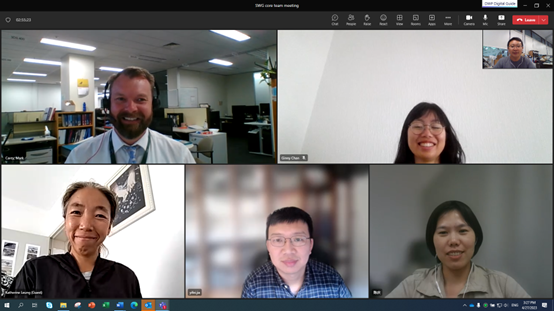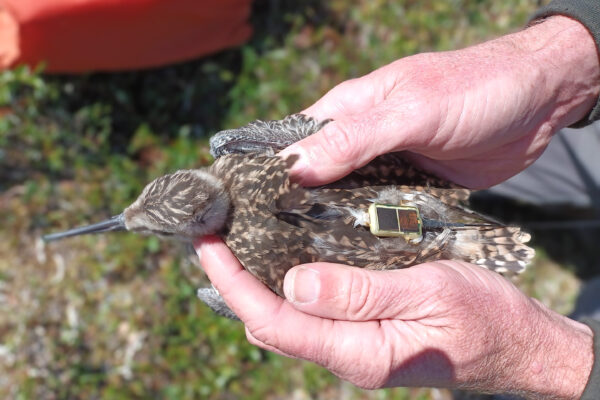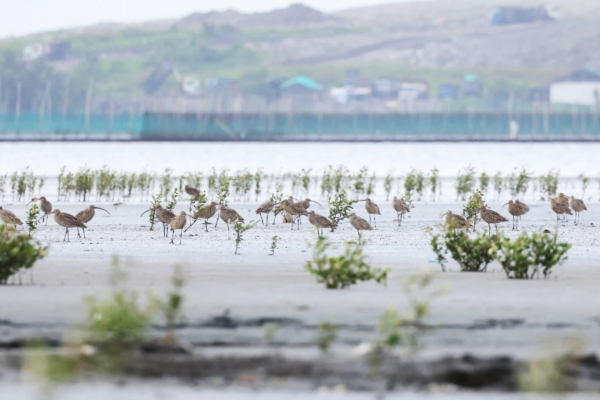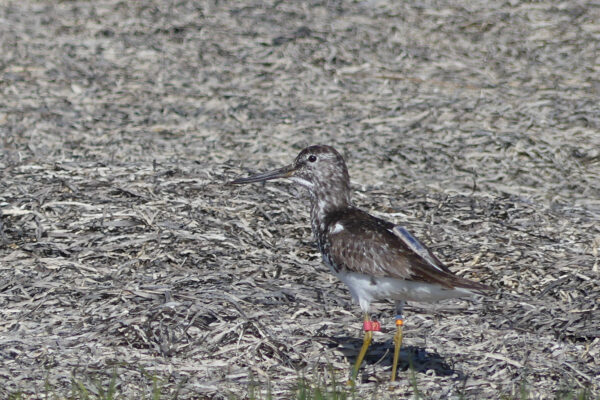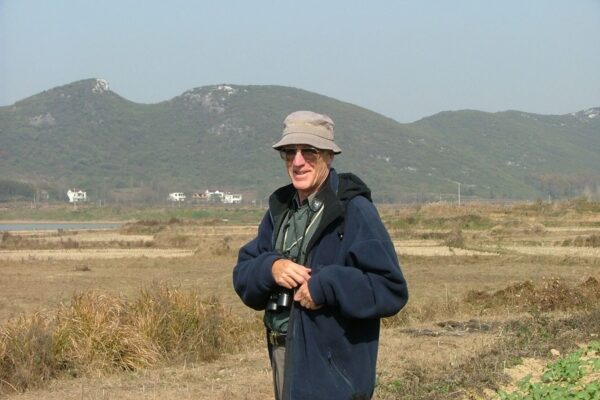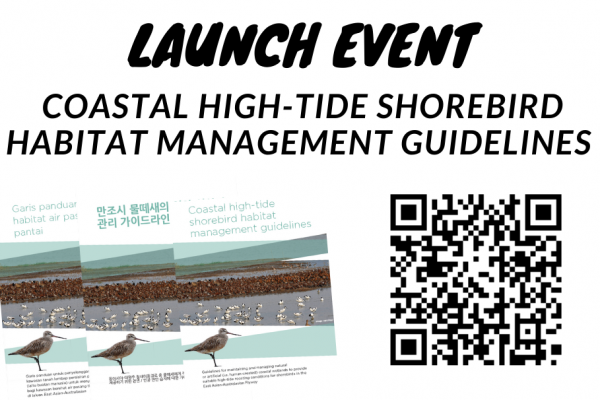-
Shorebird Working Group: Moving Forward for Successful Conservation
The EAAFP’s Shorebird Working Group (SWG) was established to promote, facilitate, and coordinate shorebird conservation, management, education and research activities within the EAAF and to improve communication between shorebird specialists and managers in the flyway. On 27th April, 2023, the SWG conducted its first Core Team meeting (virtually). This meeting was the first get-together for the acting Core Team since the SWG met at the 11th Meeting of the Partners (MOP) of the EAAF in Brisbane, Australia, on 12 March 2023. David Li, the newly elected Chair of the SWG, first introduced the current acting Core Team members, including 5 representatives of EAAFP partners, 1 representative from the EAAFP Secretariat and 4 invited members. The seven acting Core Team members who participated in the inaugural online meeting are shown in the photo below, including (left to right, top to bottom) Mark Carey, Ginny Chan, David Li, Katherine Leung, Yifei Jia and Chen Qing for Yin Yu Zhu. Not shown in the photo is Chris Hassell. Several members could not attend, including Rick Lanctot, Phil Straw and Micha Jackson. Core Team of EAAFP Shorebird Working Group (left to right, top to bottom: Mark Carey, Ginny Chan, David Li, Katherine Leung, Yifei Jia and Chen Qing) The 2.5-hour meeting included an introduction of the acting Core Team, a discussion of the Work Plan and roles of the Core Team members, proposed revision of the SWG Terms of Reference (TOR), and a decision to hold an all-members meeting on 31 August GMT 6-9 am. Prior to the meeting, the acting Core Team members completed a questionnaire about the proposed Work Plan for the EAAF Partnership’s Shorebird Working Group, 2023-2025. The questionnaire provided their preliminary opinion on priority actions and the role of the SWG, the importance and urgency of each listed item, and what items the Core Team members were interested in and willing to lead. Based on the results of this questionnaire, in the coming 2 years, the Core Team decided to focus primarily on these 4 areas: To support the identification of important areas and promote monitoring of migratory shorebirds, To support conservation of shorebird species and their habitats, To support capacity building and promote science for shorebird conservation and management, and To enhance communication-related to shorebird conservation. The Shorebird Working Group’s TOR was also revised to reflect recent changes in the structure and function of the SWG as agreed at the SWG meeting at the 11th MOP of the EAAF. The acting Core Team agreed to hold an online meeting for all SWG members on 31 August 2023 to request full endorsement of the TOR, the members of the Core Team, and the Work Plan and roles proposed by the acting Core Team members. The Core Team meeting concluded with a fruitful discussion on the next steps before the next Core Team meeting planned for the end of June. It allowed participants to share knowledge and experiences, plan for future conservation efforts, and build an effective mechanism to support the group’s work. Learn more about EAAFP Shorebird Working Group: https://www.eaaflyway.net/shorebird-working-group/
Continue reading -
Establishment and Coordination of the EAAF Shorebird Migration Tracking Group
EAAFP Small Grant Fund project by Ying Chi Chan University of Groningen Banding shorebirds as a means of understanding their movements has been conducted in the EAAF for several decades. Nowadays, an increasing number of people all along the flyway contribute to this effort by reporting sightings of previously tagged birds (e.g., Lagassé et al. 2020). These contributions have resulted in a greater understanding of the distribution and timing of shorebird migrations. Recently, researchers have employed various technologies, such as satellite transmitters, geolocators, and GSM-based trackers, to map out the migratory routes of these birds. This has helped us gain insights into individual migration patterns and has filled in gaps in knowledge in areas where there are fewer bird-banding conducted and sightings of banded birds (e.g. Chan et al. 2019). The scientific information generated by these studies has been crucial in recognizing the importance of the Yellow Sea, leading to the designation of important areas as a new World Heritage Site (e.g. Piersma et al. 2017). Although an increasing number of tracking studies have been conducted by various institutions/groups across the flyway, there is little coordination and lack of prioritization on species and populations to be tracked. Furthermore, the wide variety of techniques, their constant development, difficulties in analyzing data, and raising funds to purchase the tracking devices have created challenges for people hoping to begin using these techniques. Given the urgent need to conserve declining migratory shorebird populations across the EAAF, it is imperative to create a Shorebird Tracking Group that can provide a platform to share information and techniques, allow and promote collaborations across the nonbreeding range of a species and across multiple species using the same site, utilizing the full potential of tracking data in conservation of shorebirds in this flyway. The need for this group was apparent during enthusiastic discussions by participants of the 1st EAAF Shorebird Science Meeting held in November 2020. The group is open to anyone interested in studying or learning about shorebird migration. Here are the goals of the EAAF Shorebird Tracking Group (EAAF STG): establish group membership and tracking project directory to determine existing work occurring within the EAAF, coordinate/lead on-line meetings to facilitate exchange of ideas and techniques, promote collaborations between researchers, and between researchers and conservation organizations, and garner support to projects and initiatives that promote shorebird conservation in the EAAF using science-based tracking information. Project Directory A project directory of past and current shorebird telemetry studies occurring within the EAAF was established. For each project, principal investigators are asked to list the species, tag deployment location, tracking device, years of study, organisation, contact person and email, and a link to their project website (optional). This allows an overview of what has and has not occurred to date, helping to identify knowledge gaps and prioritize future collaborative projects. Please view the current project directory here: trackeaaf.org/projects Webinar series Regular online meetings in the form of seminars on the topic on migration and movement ecology or tracking techniques were organized by the EAAF STG. Screenshots of EAAF Shorebird Tracking Group Webinar Recordings of the most recent webinars are available on a youtube channel https://www.youtube.com/@trackeaaf From April 2021 to November 2022, there were 11 webinars organized, on average every 1-2 months. There were 21 speakers, and 3 of them gave a talk two times. Some webinars were organized with a theme, such as the Bar-tailed godwit (12 July 2021) and Nordmann’s Greenshank (1 September 2022). Researchers studying populations of shorebirds in flyways other than the EAAF were occasionally invited. The purpose was to exchange information and stimulate potential collaborations. For the list of past webinars, please check our website: trackeaaf.org/activities If you are interested to receive news related to tracking shorebirds e.g. webinars related to shorebirds and/or bird-tracking organized by other organisations, conferences, and conservation activities, please request to join the mailing list at the website’s contact form: trackeaaf.org/contact References Battley, P. F., Warnock, N., Tibbitts, T. L., Gill Jr, R. E., Piersma, T., Hassell, C. J., ... & Riegen, A. C. (2012). Contrasting extreme long‐distance migration patterns in bar‐tailed godwits Limosa lapponica. Journal of Avian Biology, 43(1), 21-32. Chan, Y. C., Tibbitts, T. L., Lok, T., Hassell, C. J., Peng, H. B., Ma, Z., ... & Piersma, T. (2019). Filling knowledge gaps in a threatened shorebird flyway through satellite tracking. Journal of Applied Ecology, 56(10), 2305-2315. Lagassé, B. J., Lanctot, R. B., Barter, M., Brown, S., Chiang, C. Y., Choi, C. Y., ... & Wunder, M. B. (2020). Dunlin subspecies exhibit regional segregation and high site fidelity along the East Asian–Australasian Flyway. The Condor, 122(4), duaa054. Piersma, T., Chan, Y. C., Mu, T., Hassell, C. J., Melville, D. S., Peng, H. B., ... & Wilcove, D. S. (2017). Loss of habitat leads to loss of birds: reflections on the Jiangsu, China, coastal development plans. Wader Study, 124(2), 93-98. Join the EAAF Shorebird Tracking Group: https://forms.gle/CHbntPrMCGypGiZK6 East Asian-Australasian Flyway Shorebird Tracking Projects Directory: https://eaafprojects.netlify.app/ To include your project to the directory: https://form.jotform.com/210225083733043 Learn about EAAFP Shorebird Working Group: https://www.eaaflyway.net/shorebird-working-group/ The project was funded through the 2021 EAAFP WG/TF Small Grant Fund. View the report, Click here.
Continue reading -
Seminar and Training on Shorebird Banding for Bird Conservationists at Trisik Beach, Kulon Progo, Special Region of Yogyakarta, Indonesia
2022 EAAFP Small Grant Fund Project by Ahmad Zulfikar Abdullah Endemic Indonesia Society Mist net installation practice © Endemic Indonesia Society Birdbanding is a technique used to study wild birds which had been applied internationally in numerous researches and requires a distinct set of skills and expertise, including equipment use, bird safety, and alertness during the entire process. Bird banding has been a regular activity in Indonesia since the 1950s, and is supervised by the Indonesian Bird Banding Scheme (IBBS). Since 2010, bird banding groups have emerged from different cities including Bogor, Yogyakarta, and Surabaya. However, the majority of these groups have failed to maintain a consistent program for the past few years, which resulted in the absence of new bird banding activists. This is shown by the stagnant number of licensed bird bander in Indonesia. With support from the EAAFP Small Grant Fund for Working Groups and Task Forces, Endemic Indonesia Society organized a bird banding-focused event through seminars and training. This event, which was held on November 19-23, 2022, has been conducted in Yogyakarta due to its ease of access and could involve the active bird banding community, Jogja Birdbanding Club. We believe that reintroducing bird banding through seminars and hands-on workshops to bird conservation activists, especially the younger age group, is urgently needed to ensure the continuity of bird banding scheme in Indonesia as well as keeping information on bird migration updated. Seminar The first plan for the seminar, which was held offline, was changed to online in order to reach more participants. This seminar has presented speakers from ornithology experts, especially those related to bird banding and wetlands. Participants who attended the event came from various backgrounds such as bird researchers, bird watchers, university students, local NGOs, government staff especially in the environment sector, and the local community. Presented seminar topics including : National and Global Perspective of Bird Banding Speaker: Prof. Dr. Dewi Malia Prawiradilaga, MSc., PhD. (National Research and Innovation Agency; Indonesian Bird Banding Scheme) Bird Banding Techniques & Application in Research Speaker: Ign. Pramana Yuda, Ph.D. (Lecture of Atma Jaya Yogyakarta University; President of Indonesian Ornithologists Union) Wetlands and Migratory Bird Conservation Speaker : Ragil Satriyo Gumilang, S.Hut., M.Si. (Wetlands International Indonesia) Goverment’s Role in Migratory Bird Conservation in Trisik Beach Speaker: Tri Dibyo Sumbogo (Natural Resources Conservation Agency of Yogyakarta) First Speaker Second Speaker Third Speaker Fourth Speaker The seminar that was held one day before the training went successfully. Discussions during the seminar showed that the topics presented by the speakers were well understood by the participants. From this seminar, it can be concluded that wetland conservation is generally known by the public, but it's the exact opposite in bird banding. It needs to be collaborative activities that involve many stakeholders if we want to apply this method to support bird and habitat conservation programs. Training The training was attended by 20 participants who had registered and been selected. This activity was assisted by trainers and assistants who have bird banding licenses issued by the Indonesian Bird Banding Scheme. The main trainer was Iwan Febrianto from the Yayasan Ekologi Satwa Liar Indonesia. Participants came from various backgrounds such as students, lecturers, NGO activists, bird watchers, and veterinarians. These activities were divided into two stages. The first stage was conducted twice, in July and September, with passerine birds as the target. This stage aimed to introduce and familiarise the participants with bird banding techniques. Some of the birds that were successfully tagged including: Actitis hypoleucos, Alophoixus bres, Arachnothera longirostra, Cinnyris ornatus, Halcyon cyanoventris, Lonchura leucogastroides, Orthotomus sutorius, Passer montanus, Pellorneum capistratum. Bird banding in July Introduce mist net installation Bird tagging Halcyon cyanoventris Bird banding in September Bird measurements Actitis hypoleucos Orthotomus sutorius The second stage, training with shorebird targets, was conducted in November in Trisik beach area and Progo River estuary. Both locations become an ideal location for our training program due to its easy access and long history of shorebird records. Briefing for participants Mist net installation practice Mist net installation practice Mist net installation practice During the four days of training, it was raining almost every evening and night with strong winds. This condition causes the installation of nets to become not optimal considering that shorebird banding is ideally carried out at night. The training was maximized in the morning and afternoon by targeting birds in the location, which were mostly passerine birds. Some of the birds that were successfully tagged including: Alcedo coerulescens, Anthreptes malacensis, Cisticola juncidis, Geopelia striata, Lonchura leucogastroides, Lonchura punctulata, Orthotomus sutorius, Passer montanus, Prinia inornata, Turnix suscitator. Calidris alba Calidris melanotos Phalaropus fulicaria Philomachus pugnax The conclusion from these events is that there are needs to be encouragement in the form of continuous activities to optimize the use of this method, in order to support bird and habitat conservation efforts. The project was funded through the 2022 EAAFP WG/TF Small Grant Fund. View the report, Click here.
Continue reading -
Not a Threat: How Vegetation Expansion affecting the pattern of Habitat Used by Migratory Waterbirds at Pantai Cemara, Jambi
EAAFP Small Grant Fund Project by Cipto Dwi Handono EKSAI Foundation Spotted Greenshank (Tringa guttifer) recorded at Pantai Cemara, Jambi during this research (November 2021) © Cipto Dwi Handono In 2021 EKSAI Foundation received a small grant fund from the EAAFP to evaluate the potential threat of vegetation expansion on the mudflat of Pantai Cemara, Jambi. From the monitoring in 2020, EKSAI Foundation recorded a massive growth of Ipomoea sp., that later identified as Ipomoea pes-carpae together with a decrease of migratory waterbirds number at Pantai Cemara, Jambi. From 4 days of monitoring and vegetation analysis at Pantai Cemara, Jambi, EKSAI Foundation recorded 35 species of migratory waterbirds and a maximum count of 3.445 birds at Pantai Cemara, Jambi. This result shows a stable number from 2020 which recorded 2.836 birds from 30 species. EKSAI Foundation also recorded two new species that had never been recorded at Pantai Cemara before: Lesser Crested Tern and Broad-billed Sandpiper. Vegetation analysis done by EKSAI Foundation shows that all of the vegetation on site are native species: Ipomoea pes-carpae (the most dominant species on mudflat), Sea-pine, and Avicennia sp. Ipomoea pes-carpae was recorded as invasive in three countries: Spain, Anguilla, and South Africa (Dana, et al., 2020; Connor et al., 2021; and Foxcroft et al., 2020), hence, the result from this monitoring can not prove that ipomoea pes-carpae are invasive and threat the migratory waterbirds community at Pantai Cemara, Jambi. Despite that result, EKSAI Foundation notices that vegetation growth still affects the birds, especially in migratory waterbirds' habitat use and selection. In fig. 01 : (1), (2), and (3) we can compare the mudflat area used by migratory waterbirds at Pantai Cemara, Jambi in 2019, 2020, and 2021. Fig 01. (1) Vegetation and migratory waterbird in 2019 Fig 01. (2) Vegetation and migratory waterbird in 2020 Fig 01. (3) Vegetation and migratory waterbird in 2021 From fig 01, we can see that the migratory waterbird flocks are shifting following the vegetation growth to find the remaining open mudflat at Pantai Cemara, Jambi. Together with the vegetation growth, the team of EKSAI Foundation found a new-form mudflat that was used by migratory waterbirds flock in 2021. This new-form mudflat is formed on the southeast side of Pantai Cemara. We need to continuously survey to monitor the vegetation and mudflat at Pantai Cemara, so we can understand the pattern of migratory waterbirds' habitat at Pantai Cemara. This information is very valuable for migratory waterbirds’ habitat management. Conclusion The expansion of vegetation especially Ipomoea pes-carpae growth at Pantai Cemara Jambi does not identify as a threat to migratory waterbirds, yet still affects the area used by migratory waterbird flocks at Pantai Cemara, Jambi. Based on the interview with local people, a large land clearing near Desa Cemara might cause the increase of organic waste in the river and estuary that possibly be a cause of the increase of vegetation growth at Pantai Cemara, Jambi. During this research, we identify 35 species of migratory waterbirds with a maximum count of total migratory waterbirds is 3.445. This result shows that the migratory waterbirds number from 2020 to 2021 is stable and tends to increase through the vegetation is still growing intensively. The result from this research does not show that the vegetation growth threatened the migratory waterbirds community, but still affects the area used by migratory waterbirds due to the mudflats covered by Ipomoea pes-caprae and other vegetation at Pantai Cemara. The local government and local agencies responsible for the management of Pantai Cemara are committed to proposing this area to be a new Flyway Network Site in Indonesia in 2022, our team will help and follow up this commitment and help to compile the SIS together with all the responsible authorities. The project was funded through the 2021 EAAFP WG/TF Small Grant Fund. View the report, Click here. For inquiries, contact Cipto Dwi Handono at ciptodwihandono@gmail.com
Continue reading -
The search for Far Eastern Curlews in the Philippines
Fig. 1. Far Eastern Curlews in Tanza, Navotas City 2022. © Irene Dy Far Eastern Curlew (Numenius madagascariensis) is a large shorebird species found in the East Asian-Australasian Flyway. It is assessed by the International Union for the Conservation of Nature (IUCN) as an Endangered species and is part of Appendix I of the Convention on Migratory Species (CMS). The species is mainly threatened by habitat loss due to conversion of mudflats for agricultural purposes, mangrove plantation directly in the mudflats, reclamation, and urbanization. They also face threats such as solid waste and water pollution, fishing bycatch, human disturbance, and climate change. The Philippines is a mega diverse country found in the Southeast Asian region. It is home to about 725 species of birds, wherein 278 species are migratory or accidental species. As an archipelagic country comprising of 7,640 islands, it has extensive coastal shorelines and bodies of water that are ideal for shorebirds including curlews. Figure 2. Philippine Map showing major areas surveyed In selected dates from October to December 2022, eight major areas in the Philippines were visited to conduct census of Far Eastern Curlew (Fig. 2). In mainland Luzon, sites surveyed were Pamarawan in Bulacan province, Tanza in National Capital Region, and localities in La Union province. In Bicol Region, Masbate localities were surveyed. In the Southwestern part of Greater Luzon, Mindoro localities were surveyed. And in the West Visayas Region, Cebu, Negros, and Iloilo were the areas surveyed. All surveys were led by Irene Dy, a professional Filipino bird guide and bird photographer. She has conducted multiple birding expeditions, both personal and professional guidance as well as volunteered for local and national environmental NGOs and other organizations for awareness raising and conservation of Philippine birds. The Far Eastern Curlew census started on 28 October, 2022, until 28 December, 2022 taking into account the tide levels in each of the areas surveyed. Pamarawan surveys were conducted on 28 October, 2022 and 27 November, 2022. Five sites were surveyed: Vitas Mudflat, Sandbar-Mudflat, Pulo-Pulo Mudflat, Berting’s Salt Farm, and Albert’s Salt Farm. A total of 45 species was recorded throughout the survey period with a maximum total count of 17,012 individuals. On Far Eastern Curlew, only one individual was recorded at Pulo-Pulo Mudflat. Other significant records were Nordmann’s Greenshank, Great Knot, and Chinese Egret. In Tanza, Navotas City, surveys were conducted on 31 October, 2022 and 01 November, 2022. This area had the highest number of Far Eastern Curlews recorded, with a maximum total count of 99 individuals. Far Eastern Curlew flock spread across the water edge of mudflat and the drier part near the mangrove area. Individuals were observed to be either resting, sleeping, foraging, actively vocalizing in the mudflat, duetting in pairs while in flight, or actively vocalizing flock while in flight from mudflat going to the mouth of Batasan River. Accounting all the sightings, a total of 44 species of birds were recorded and with a maximum total count of 13, 882 individuals. Other threatened species include Great Knot and Chinese Egret. In Mandaue City, Cebu, the surveys were conducted from 12-13 November, 2022. Four sites were surveyed: Fishpond site, Mudflat 1A, Mudflat 1B, and Mudflat 1C. A maximum total count of 24 Far Eastern Curlew was recorded. As an assessment, the ponds are high tide roosting sites of the species along with several other species. Site counts are totally tidal level dependent. Far Eastern Curlews tend to congregate in large numbers in the ponds inside the mangrove area during high tide. The total count of species recorded was 33 and a maximum total count of 1,050 individuals. Threatened species recorded were the Far Eastern Curlew and Chinese Egret. In Negros Island, sites within the Negros Occidental Coastal Wetlands Conservation Area (NOCWCA) were surveyed from 15-18 November, 2022. These include barangays Tibsoc and Nayon in San Enrique; Pulupandan; barangays Bocana and Andulauan in Ilog. A maximum total count of ten Far Eastern Curlew was recorded. Accounting all species, a total of 54 species was recorded with a maximum total count of 4,256 individuals. In Iloilo province, surveys were conducted on 19-20 November, 2022. Sites include Balabago and Bitoon in Jaro District as well as Hinactacan in La Paz District, all within Iloilo City. A maximum total count of 36 Far Eastern Curlews were recorded. On the other hand, a total of 54 species of birds was recorded with a maximum total count of 2,941 individuals. Within the Philippines, this site has one of the most numerous sightings of Lesser Sand Plover (Tibetan) (Charadrius mongolus atrifons) hence the record during the survey was very significant. Survey in Masbate in the Bicol Region was conducted on 23-25 November, 2022. Mangrovetum Park and Pawa Mangrove Park in Masbate City as well as Naro Island Wildlife Sanctuary were the sites surveyed. A total of 47 species of birds was recorded with a maximum total count of 954 individuals. A male individual of Far Eastern Curlew was sighted at Naro Island. Threatened species recorded include Far Eastern Curlew, Chinese Egret, and a Visayan Hornbill at Pawa Mangrove Park. In Mindoro, surveys were conducted on November 28-30, 2022. Sites include Silonay and Maidlang area in Calapan City, Oriental Mindoro as well as wetlands in the municipality of Pola, Oriental Mindoro. Presence of Far Eastern Curlew wasn’t documented though another site in Calapan City, Mahal Na Pangalan Marine Park had records of Far Eastern Curlews on October 09, 2021 (two individuals) and on November 20, 2021 (one individual). Throughout the survey, a total of 33 species was recorded with a maximum total count of 3,346 individuals. La Union was the last area surveyed on December 26-28, 2022. Sites surveyed were within the towns of Santo Tomas and Agoo. A total of eight Far Eastern Curlew was recorded throughout the survey period. Accounting all the species recorded, a total of 42 species was recorded with a maximum total of 1,267 individuals. Aside from Far Eastern Curlew, threatened species include the Java Sparrow, Chinese Egret and Philippine Duck. Figure 3. Maximum total counts of Far Eastern Curlew in each of the main areas surveyed Figure 4. Total species recorded in each of the main areas surveyed Figure 5. Maximum total count of individuals in each of the main areas surveyed Throughout the survey period, Irene Dy was also able build capacity and influence locals as well as government personnel regarding bird identification and informing biodiversity conservation. They are now aware of the different species of migratory shorebirds, their importance, and their habitats. Figure 6. Local from Bitoon, Lapaz District, Iloilo City, Iloilo Province observing shorebirds and waders including Far Eastern Curlew. Photo © Irene Dy 2022 The census received a lot of support from locals, local birders, local government units, as well as the Department of Environment and Natural Resources (DENR). A sincere gratitude to Lyndon Grondiano, a Cebu-based birder, who supported the survey in Cebu; Hon. Rose Faith Paas and the local government unit of Tibsoc in San Enrique, Negros Occidental as well as Kim Castańares of Ilog, Negros Occidental for their support and assistance in the surveys conducted in Negros; the DENR-Provincial Environment and Natural Resources Office (PENRO) of Oriental Mindoro through Amor Asi and Earl Meman, and the DENR-Community Environment and Natural Resources Office (CENRO) of Socorro, Oriental Mindoro through Jose Maria Fontanilla, Joey Albert San Diego, and Adrian Catud for their support and assistance in the surveys conducted in Mindoro; and DENR-Community Environment and Natural Resources Office (CENRO) of Mobo for their support and assistance in the surveys conducted in Masbate. Thanks to Dr. Nial Moores and Dave Bakewell for the support and advice on species identification and confirmation. Lastly, the sincerest gratitude to the government of Hwaseong City and the EAAFP Secretariat for the valuable financial support to initiate the Far Eastern Curlew census and conservation in the Philippines. Prepared by Irene Dy and Virtito Natural Jr. Citation: Dy. I & V. Natural. 2023. Far Eastern Curlew (Numenius madagascariensis) Census (2022, the Philippines). EAAFP Secretariat, Hwaseong Eco Foundation, and Hwaseong City. [link]
Continue reading -
Tracking Nordmann’s Greenshanks from Schaste Bay, Russian Far East with Druid Nano GPS devices
Image 1. A banded Nordmann’s Greenshank, with color bands and red engraved flag P2, tagged with a 3.5…
Continue reading -
Mark Barter Travel Award and Australasian Shorebird Conference 2022
Following the announcement of the Australasian Shorebird Conference (ASC) organized by Australasian Wader Study Group and Queensland Wader Study Group, to be held virtually on 29-30 October 2022 (link), please mark the date and stay tuned for further information about the program, registration arrangements, and call for abstracts will be forthcoming in the near future. In line with the ASC, the Mark Barter Travel Award nomination has been launched. Mark Barter Travel Award The AWSG Committee will again be offering an Award to honour the late Mark Barter. Shorebird workers and others will be aware of the tremendous contribution that Mark made to the understanding and conservation of shorebirds in the East Asian- Australasian Flyway over many years. In view of Mark’s substantial contributions through monitoring, training and education focused on the Yellow Sea region, this Award seeks to build on Mark’s work by encouraging the further experience and development of young people who have demonstrated an interest in this work. Scope of Award The recipient of this Award will be sponsored to participate in the 2022 Australasian Shorebird Conference (ASC) which will be held online 29th – 30th September. The Award will cover the cost of registration for the recipient. Selection Criteria As the Award is focused on the Yellow Sea region, applications are sought from interested people from China, the Republic of Korea and the Democratic People’s Republic of Korea. Applicants should have a demonstrated interest in shorebirds and supporting their conservation through a scientific approach. The successful applicant is strongly encouraged to give an oral or poster presentation to the ASC. Applications Applications with supporting information should be forwarded to awsgconference@gmail.com by 1 August 2022. At least two referees should be nominated in the application. Mark Barter. Photo courtesy: Australasian Wader Study Group
Continue reading -
Learn about Migratory Shorebirds with Sungei Buloh Wetland Reserve!
Shorebird migration is one of Nature’s most enigmatic phenomena. To increase awareness and understanding on these amazing birds, Sungei Buloh Wetland Reserve created ‘Shorebird Migration’, an educational video that…
Continue reading -
Launch of “Coastal High-tide Shorebird Habitat Management Guidelines”
The EAAFP Secretariat, together with the Australasian Wader Studies Group are hosting a webinar “Launch Event: Coastal High-tide Shorebird Habitat Management Guidelines” on 17 September at 4pm…
Continue reading

